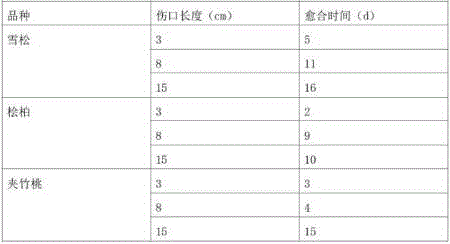Wound repairing agent for landscape plants
A wound repair and plant technology, used in plant growth regulators, plant growth regulators, animal repellents, etc., can solve the problems of low survival rate of transplanted trees, easy freezing of wound edges, and reduced landscape effects. The effect of cell division speed, preventing wound infection, avoiding contamination
- Summary
- Abstract
- Description
- Claims
- Application Information
AI Technical Summary
Problems solved by technology
Method used
Image
Examples
Embodiment 1
[0013] Example 1: 500 parts of ethylene-vinyl acetate copolymer, 700 parts of gelatin, 200 parts of alum, 100 parts of erythromycin, 3 parts of 6-benzylaminopurine, 8 parts of dihydrozeatin, 3 parts of isopentenyl adenine 5 parts of isopentenyl adenosine, 15 parts of indole acetic acid, 5 parts of naphthalene acetic acid, 16 parts of sulfamethoxazole, 10 parts of folpet, 3 parts of 2-methyl-5-nitroimidazole-1-ethanol 1 part, 1 part of deltamethrin, 2 parts of triclosinate, 8 parts of (1-naphthyl)-N-methylcarbamate.
Embodiment 2
[0014] Example 2: 700 parts of ethylene-vinyl acetate copolymer, 800 parts of gelatin, 100 parts of alum, 150 parts of erythromycin, 4 parts of 6-benzylaminopurine, 4 parts of dihydrozeatin, 5 parts of isopentenyl adenine Parts, 6 parts of isopentenyl adenosine, 10 parts of indole acetic acid, 8 parts of naphthalene acetic acid, 18 parts of sulfamethoxazole, 11 parts of folpet, 5 parts of 2-methyl-5-nitroimidazole-1-ethanol 2 parts, 2 parts of deltamethrin, 5 parts of triclosinate, 2 parts of (1-naphthyl)-N-methyl carbamate.
Embodiment 3
[0015] Example 3: 800 parts of ethylene-vinyl acetate copolymer, 500 parts of gelatin, 150 parts of alum, 200 parts of erythromycin, 2 parts of 6-benzylaminopurine, 6 parts of dihydrozeatin, and 6 parts of isopentenyl adenine Parts, 2 parts of isopentenyl adenosine, 13 parts of indole acetic acid, 10 parts of naphthalene acetic acid, 12 parts of sulfamethoxazole, 12 parts of folpet, 1 part of 2-methyl-5-nitroimidazole-1-ethanol 1 part, 3 parts of deltamethrin, 1 part of triclosinate, 5 parts of (1-naphthyl)-N-methylcarbamate.
[0016] A preparation method of a garden plant wound repairing agent, comprising the following steps: ① weighing raw materials according to the following parts by weight: 500-800 parts of ethylene-vinyl acetate copolymer, 500-800 parts of gelatin, 100-200 parts of alum, red 100-200 parts of mycin, 2-4 parts of 6-benzylaminopurine, 4-8 parts of dihydrozeatin, 3-6 parts of isopentenyl adenine, 2-6 parts of isopentenyl adenosine, 10-15 parts of indoleaceti...
PUM
| Property | Measurement | Unit |
|---|---|---|
| Length | aaaaa | aaaaa |
| Depth | aaaaa | aaaaa |
Abstract
Description
Claims
Application Information
 Login to View More
Login to View More - R&D
- Intellectual Property
- Life Sciences
- Materials
- Tech Scout
- Unparalleled Data Quality
- Higher Quality Content
- 60% Fewer Hallucinations
Browse by: Latest US Patents, China's latest patents, Technical Efficacy Thesaurus, Application Domain, Technology Topic, Popular Technical Reports.
© 2025 PatSnap. All rights reserved.Legal|Privacy policy|Modern Slavery Act Transparency Statement|Sitemap|About US| Contact US: help@patsnap.com

